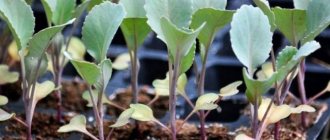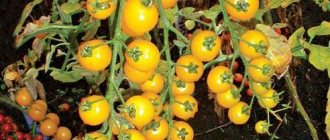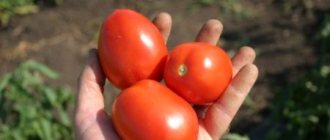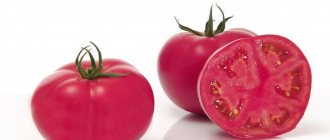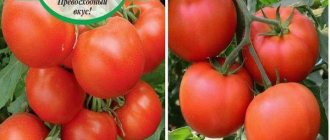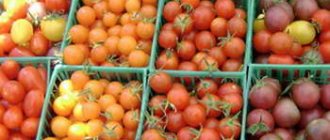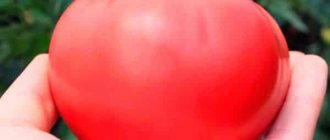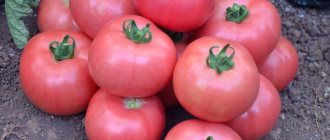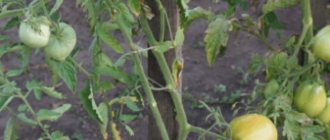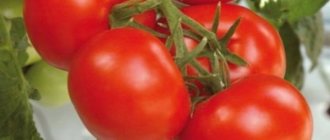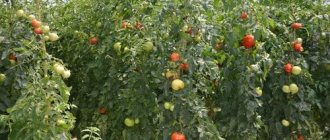Description
The Sibiryak tomato bush has the following features:
- dark green leaves;
- height of the main stem – 160–180 cm;
- vegetables appear every 3-4 leaves;
- 8-9 clusters are formed on the plant;
- clusters bear 5-6 fruits.
Hybrid f1
The hybrid is characterized by increased resistance to adverse conditions, which cannot be compared with ordinary varietal tomatoes. Siberian F1 grows quickly, has strong immunity to diseases and pests and produces an excellent harvest.
Distinctive features
The culture belongs to the indeterminate type of plants. It is characterized by stable and strong bushes. The hybrid is not afraid of cold weather and overheating. In northern latitudes, tomatoes are grown in greenhouses; in the south of the country, Sibiryak successfully bears fruit in open ground.
Fruit characteristics, yield
Fruiting begins 120–130 days after emergence. Characteristics of tomatoes:
- the weight of one tomato is 300–400 g, but there are also fruits weighing 600 g;
- tomatoes have slight ribbing;
- the shell is durable, shiny, does not crack;
- the flesh is fleshy;
- the number of seeds in tomatoes is small;
- The taste of tomatoes is sweet and sour.
Subject to agrotechnical rules, from 1 sq. m vegetable growers harvest up to 10 kg of crop.
Description and characteristics of the variety
The Mamin Sibiryak tomato has medium-sized bushes, reaching 120-150 cm. In terms of ripening, it is mid-ripening, but in some catalogs it is recorded as early-ripening. The fruits ripen in clusters of 5-7 pieces; 5-8 such clusters can be placed on a bush. The average weight of tomatoes is 100-170 g, they have an elongated cylindrical shape, thickening at the end. The color is red, the taste is pleasant and rich.
How to grow seedlings
Sowing seeds for seedlings is carried out in the second half of March, two months before the intended planting of plants in a permanent place. The soil for this can be purchased at a gardening store or prepared independently.
Important! Containers for seedlings must have a drainage layer. For this, small pebbles or expanded clay are used.
Seed preparation
The seeds are disinfected. To do this, they are placed in a 1% solution of potassium permanganate for 20–30 minutes, then washed in running water and sprayed with a growth stimulator, for example, Heteroauxin, Epin or Kornevin.
For quick pecking, two days before sowing, the grains are laid out on a damp cotton cloth and covered with it. Place the saucer with seeds in a cool, dark place. The fabric with seed material is periodically moistened, but the seeds are not allowed to float in the water.
Container and soil
Seedlings are grown in wooden boxes or in special containers with cells. Some vegetable growers use containers from improvised materials, for example, cut-off juice or milk boxes. Still, most gardeners use peat tablets or cups.
To grow healthy seedlings, use high-quality soil:
- most gardeners purchase ready-made soil mixture for seedlings;
- some prepare the substrate themselves by mixing garden soil, humus, sand (sawdust) and wood ash in a ratio of 2:1:1:1.
Before use, the soil is disinfected - watered well with boiling water or a 1% solution of potassium permanganate. This procedure will destroy all possible bacteria and larvae that cause diseases in tomatoes.
Sowing
Seeds are planted at a distance of 2-3 cm from each other. The embedment depth is no more than 0.8–1 cm. Several holes are made at the bottom of the containers to drain excess liquid. The container with seeds is covered with film or transparent glass and placed in a warm room (+25 °C) for several days.
Growing and care
After emergence, the seedlings are placed in a bright place, for example, on a windowsill or veranda. If the weather is cloudy and the plants do not have enough light, turn on artificial lighting. To do this, fitolamps are evenly installed above the bushes.
During this period, the plants are watered with settled water at room temperature. Do not allow the soil to become waterlogged or dry out.
When the seedlings have 2-3 true leaves, the young bushes are transplanted into separate containers. Spacious boxes are used for this.
7–10 days after picking, the plants are fertilized for the first time with special preparations, for example, “Biohumus” or “Baikal EM1”. Solutions are prepared strictly according to the instructions indicated on the packaging.
14 days before planting the plants at a permanent place of growth, the seedlings are hardened. To do this, take the tomatoes outside or onto the balcony for a couple of hours. The time spent in the fresh air increases every day.
How to grow tomatoes
Plants are planted in a permanent location in consistently warm weather. In case of returning cold weather, vegetable growers have shelters made of film or spunbond, which cover the tomatoes. The crop has strong immunity to most diseases, but experienced gardeners, just in case, treat the soil with a weak solution of potassium permanganate.
Landing
The area for tomatoes has been prepared since the fall. The bushes are planted at a distance of 40–45 cm from each other, and 60 cm are left between the rows. A small layer of ash and compost is placed at the bottom of the holes, then watered. After planting, the plants are moistened again and supports are installed.
Care
Tomatoes are watered once a week, or twice in hot weather. The crop is moistened in the morning or evening, at the root, so that splashes do not fall on the leaves and stem. To do this, use settled or rainwater at room temperature.
After watering, the soil around the tomatoes is loosened and at the same time weeds are removed, which takes nutrients from the plants. The soil is also mulched with hay or grass. This will retain moisture in the soil longer and prevent weed growth.
Two weeks after planting the plants, fertilizer is applied to the soil. To do this, use an infusion of mullein or fermented herbs. The next feeding is carried out after the formation of ovaries, mineral potassium and phosphorus fertilizers are added.
Important! All fertilizing is applied to the moist soil after watering.
If the crop grows in a greenhouse, then the structures are regularly ventilated by opening two opposite windows or doors. This is done to reduce air humidity so that the plants do not suffer from rot.
The bushes form into one stem. As the tomatoes grow, they are tied to a support. Stepchildren and yellow foliage are removed.
Features of cultivation and possible difficulties
The crop has good resistance to cold conditions, so tomatoes are grown even in northern regions, but under covering material or in greenhouse structures.
Cultivating the Sibiryak hybrid is no different from growing other tomatoes. To obtain an abundant and high-quality harvest, vegetable growers follow the rules of agricultural technology.
Diseases and pests
The hybrid has strong immunity to the following nightshade diseases:
- cladosporiosis;
- tobacco mosaic;
- Fusarium
Despite this, vegetable growers take preventive measures:
- disinfect seed material;
- disinfect the greenhouse, equipment and soil;
- follow the rules of crop rotation;
- treat plants for preventive purposes with “Fitosporin”;
- ventilate the greenhouse structure.
The most common pests on plants are Colorado potato beetles, slugs and spider mites. Insects are collected by hand or tomatoes are treated with folk remedies. To do this, use a decoction of wormwood, an infusion of garlic, onion or hot pepper.
Planting and caring for plants in a greenhouse
Holes for planting tomatoes are made at a distance of 40–45 cm in a row and 60 cm between rows. Ash and compost are added to them and watered. After planting, the plants are watered again and supports are installed.
Further care consists of:
- Regular watering, once a week. Water the plants at the root, preferably in the morning, with warm water.
- Weeding and loosening the soil around tomatoes.
- Mulching the soil with grass or hay. Mulching protects the soil from drying out, reduces evaporation, and prevents the growth of weeds.
- Feeding: during the first weeks - an infusion of fermented grass or mullein diluted in water. After the formation of ovaries, mineral potassium and phosphorus fertilizers are added. If necessary, microelements are added to the plant diet. It is important to carry out all the subcortex on damp soil - after watering.
- Ventilation of greenhouses using vents and doors to reduce air humidity.
- Formation of plants into one stem. Tomatoes are tied to supports as they grow, and stepsons and yellowed leaves are cut off. When there is a threat of plant disease, they are sprayed with phytosporin or other antifungal agents.
The nuances of growing in open ground and in a greenhouse
Siberian fruit bears fruit on almost any soil, but for this, vegetable growers follow the rules of crop rotation.
Good predecessors for tomatoes:
- beet;
- turnip;
- green onions;
- legumes;
- pumpkin;
- squash;
- zucchini;
- cucumber.
Tomatoes are not grown after potatoes, tomatoes and other nightshades earlier than 3-4 years. Otherwise, the soil becomes a potential carrier of infections and pest larvae.
On a note. Thanks to its hardiness and cold resistance, this hybrid produces a bountiful harvest in open ground, but in a greenhouse the yield is much higher.
Harvesting and application
Tomatoes are harvested 4 months after planting the seeds, usually in early August. The harvest is harvested before the first days of October.
Tomatoes are used to prepare summer salads, first and second courses, as an addition to meat portions. These vegetables also make excellent ketchups, pastes, juices and sauces.
Advantages and disadvantages
One of the main advantages of the Sibiryak tomato is the ability to harvest when other tomatoes have completed their fruiting. The hybrid, resistant to cool climatic conditions, bears fruit in the greenhouse even at a later date.
Positive qualities of tomato:
- excellent taste and aroma;
- versatility of vegetables in use;
- high productivity;
- large fruit;
- transportability;
- long-term storage of fruits;
- hybrid resistance to diseases.
Some vegetable growers consider gartering and pinching bushes to be disadvantages, but these techniques are used when growing all tall tomatoes. The main disadvantage of the hybrid is the inability to collect seeds from your own harvest.
Tomato variety Sibiryak
Let's imagine a description of the Sibiryak tomato:
- The growing season is 130-140 days.
- Good root and foliage system.
- The first brush appears above the 12th sheet.
- The fruits are red, flat, round, slightly ribbed; The pulp is juicy, dense, with a pleasant sweetish taste.
- The weight of one tomato is 400-600 g.
- The yield is 4.5 kg per plant bush.
- Plants are grown in greenhouses.
- It is necessary to tie the stem to a support.
Let's look at how to care for Sibiryak tomatoes. Seeds should be sown at the end of February, beginning of March. To prevent the sprouts from stretching upward too much, you need to leave the lamps on in the greenhouse for several hours at night. The seedlings are planted in the greenhouse at the end of April. The sprouts are planted at a distance of 40-60 cm. The leaves at the bottom of the plant and side shoots are removed. After the formation of 7 brushes, pinch the growth point. Feeding is carried out once every 2 weeks. Watering, loosening the soil, and hilling the plant are carried out regularly.
Not to be confused with namesakes
Tomatoes of Siberian selection deserve special attention due to the exceptional quality and reliability of the seed material. Among the wide variety, there are tomatoes with different growing seasons, from dwarf to tall vines, with fruits of bizarre shapes, colors and sizes.
The main advantage of zoned tomatoes is the ability to produce a guaranteed yield in difficult climatic conditions.
Mamin Sibiryak
The tomato was bred by Siberian breeders. Mother's Siberian is distinguished by its elongated fruit shape and high yield.
Description:
- the crop is mid-season, 110–115 days pass from sowing to harvest;
- tomato is a determinate plant, the bush grows up to 120–150 cm;
- the first inflorescence appears above the 7-8 leaf;
- the vegetables are cylindrical in shape, red in color and have a slight thickening at the bottom of the fruit.
- tomatoes have high taste and are excellent for canning, stuffing, preparing winter and summer salads;
- one cluster contains 5–7 fruits weighing 60–150 g;
- from 1 sq. m vegetable growers harvest up to 20 kg of crop.
The tomato has excellent commercial and consumer characteristics. It is cultivated both indoors and outdoors.
Siberian
An early-ripening and productive tomato is extremely unpretentious in care. The fruits have excellent consumer qualities. Siberian grows well in closed and open ground.
Characteristics and description:
- the tomato is early ripening, 105–110 days pass from sowing to harvesting the first harvest;
- the culture belongs to the determinant type of plants, growth stops after the formation of 4-5 clusters;
- the bush is compact, low, does not need staking or pinching;
- the first raceme appears above leaves 5–7;
- the fruits are round, smooth, with a durable bright red shell, weight 90–100 g;
- the pulp is dense but juicy, the taste is excellent;
- vegetables are stored for a long time, suitable for winter preparations, preparing salads, purees, and juices.
Short growing times for tomatoes are very important in short summer conditions. But some agricultural techniques allow you to get the harvest even faster. The positive characteristics and description of the variety make the tomato very popular among consumers.
The Sibiryachok tomato began to turn brown outside on 08/04/18. Olga Chernova's seeds
Tomato variety "Mama's Sibiryak"
Another new variety of Siberian breeders received this original name. “Mother’s Sibiryak” is truly remarkable for its unusual, elongated fruit shape and high yield.
Here is a short description of the variety:
- mid-season plant with a growth duration of 111-115 days;
- bush of determinant type, reaches a height of 120-150 cm;
- the first inflorescence is formed above the 7-8 leaf;
- fruits are cylindrical, red, shiny, slightly thickened at the bottom;
- tomatoes have excellent taste characteristics and are ideal for whole-fruit canning, stuffing, and preparing winter and summer salads;
- on one brush there are 5-7 fruits of various sizes with a weight of 60-150 g;
- the variety demonstrates excellent productivity up to 20 kg/sq.m. m.
The variety has excellent commercial and consumer characteristics. It can be grown in indoor and outdoor conditions.
Agricultural technology and care
Varieties with limited growth are easy to care for; the Mamin Siberian tomato is no exception. To care for it you will not need to perform any unusual techniques.
- Seeds for seedlings are planted 60-65 days before transplanting to a permanent place. Seed germination temperature is 23-25 degrees.
- Seedlings are planted in separate containers in the phase of appearance of 1 true leaf, and the first feeding is carried out.
- They are planted in a permanent place according to a 40 x 50 cm pattern. The variety tolerates very dense plantings up to 5-9 bushes per 1 square meter. m.
- Further care is quite traditional, consisting of watering, fertilizing, loosening the soil, and weeding.
With minimal labor costs, you can get a wonderful harvest of beautiful and very tasty tomatoes that grow in any climate zone.
Farmer reviews
Gardeners respond mostly positively to the Sibiryak F1 tomato. Vegetable growers prefer this particular hybrid for its long list of positive qualities.
Olga, Ufa : “I always try to grow tomatoes that are new to me. I decided to plant a Sibiryak hybrid. The shoots appeared quickly, the tomatoes were planted in a greenhouse. The plant is productive. Vegetables have excellent taste and pleasant aroma. I prepared so much preserved food that I later shared it with my relatives. I really liked the hybrid, I will continue to plant it.”
Svetlana, Bryansk: “I’ve been cultivating tomatoes for seven years in a row. I always buy tomatoes that do not require special attention. Based on the description, I chose the Sibiryak hybrid. I liked that the plant produces large fruits. The vegetables have an excellent presentation, as in the photo of the packaging with seeds, and most importantly, they are stored for a long time.”
